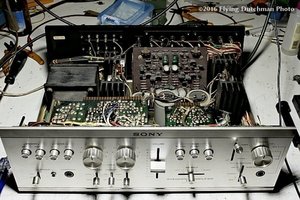Maintenance of an old but very good Amplifier
Hi, is there anybody that can teach me how to maintain and old amplifier. Understand when a capacitor is good or not, where and what to clean... this kind of stuff. Thanks a lot in advance
この質問は役に立ちましたか?
Hi, is there anybody that can teach me how to maintain and old amplifier. Understand when a capacitor is good or not, where and what to clean... this kind of stuff. Thanks a lot in advance
この質問は役に立ちましたか?
A typical maintenance job on an old Hifi amp would involve the following:
Here's a 1975 vintage Sony TA-1140 getting a tune-up:

このアンサーは役に立ちましたか?
great description, thanks a lot. Can i use the same "procedures" for separated "pre" and "final" amplifier? Thanks again
Obviously you can. After all, integrated amps like the one in the pic are just preamp and power amp in a single enclosure, the essence is the same.
Yes they get dusty inside. I used compressed air once seemed to work okay
Very helpful! Thanks
What about the solder joints they heat up in time and crack.
They will need to be redone or it will cause a short..
このアンサーは役に立ちましたか?
過去 24時間: 3
過去 7 日: 22
過去 30 日: 74
今までの合計 17,238
2 件のコメント
@taquim what make and model is your amp?
oldturkey03 さんによる
this one http://www.thevintageknob.org/kenwood-L-...
Giovanni Avila さんによる